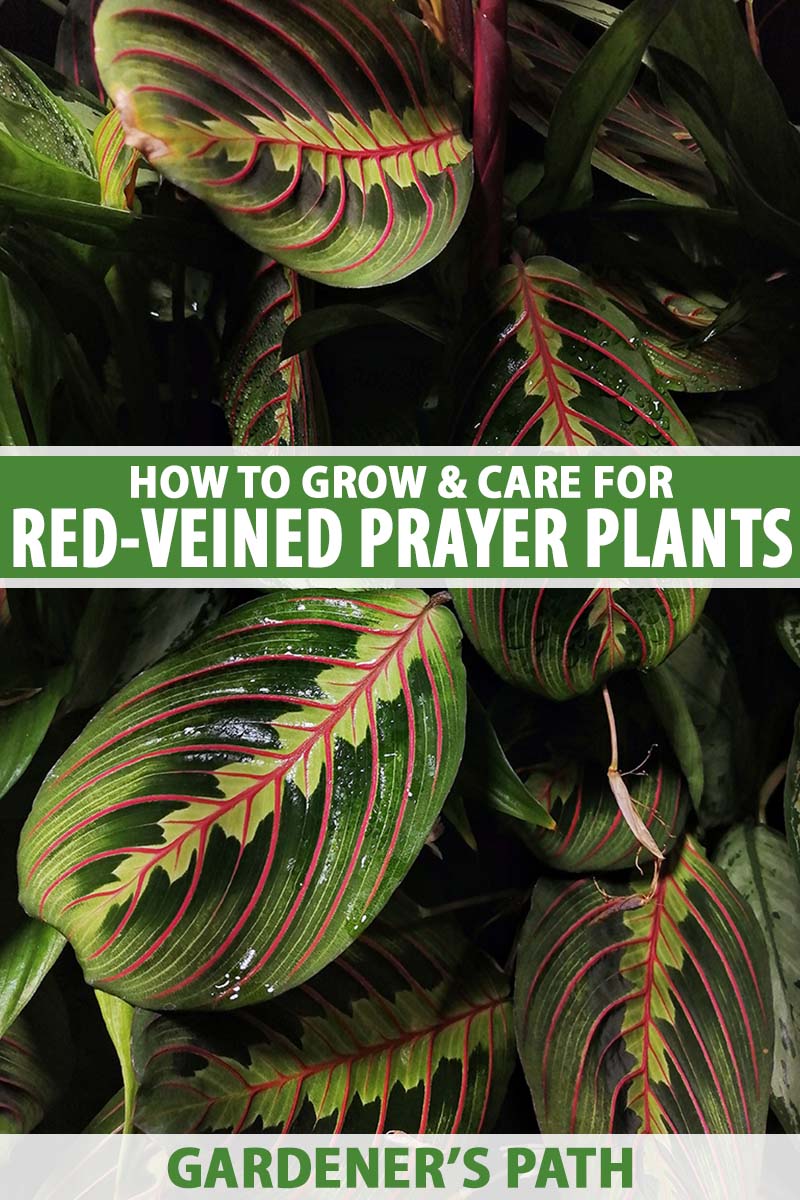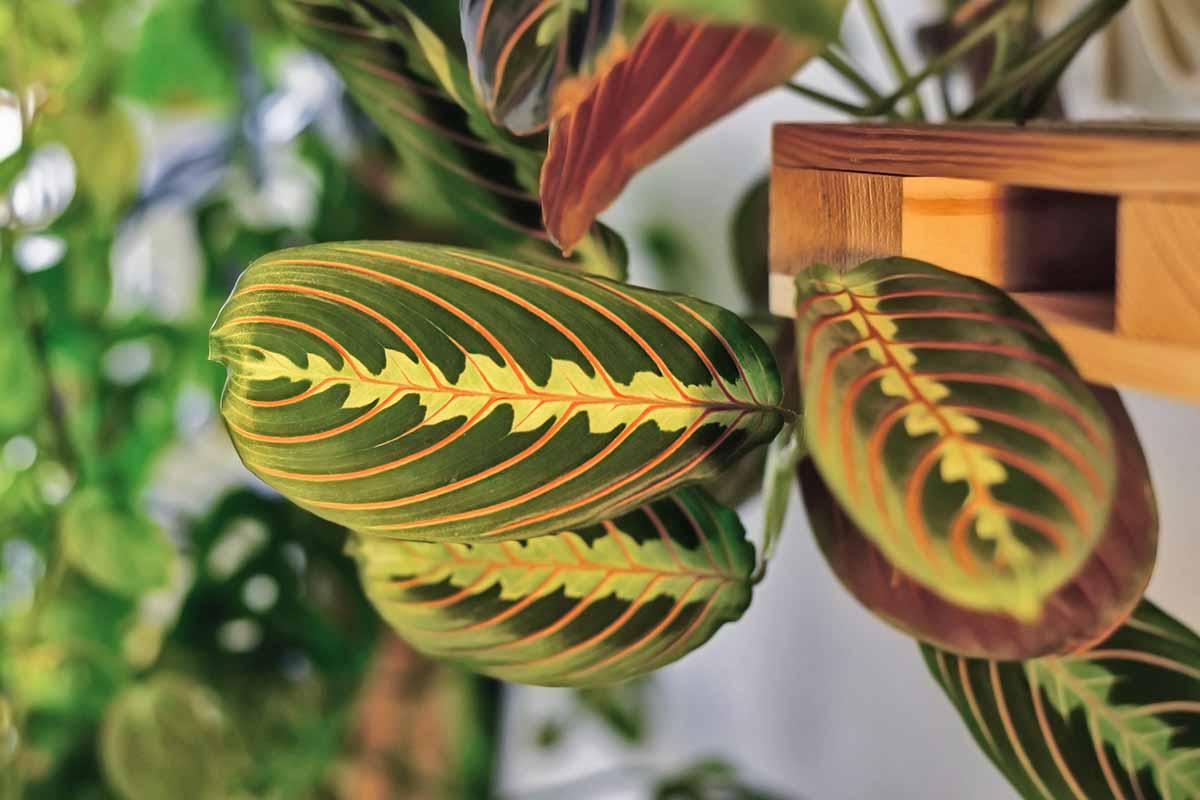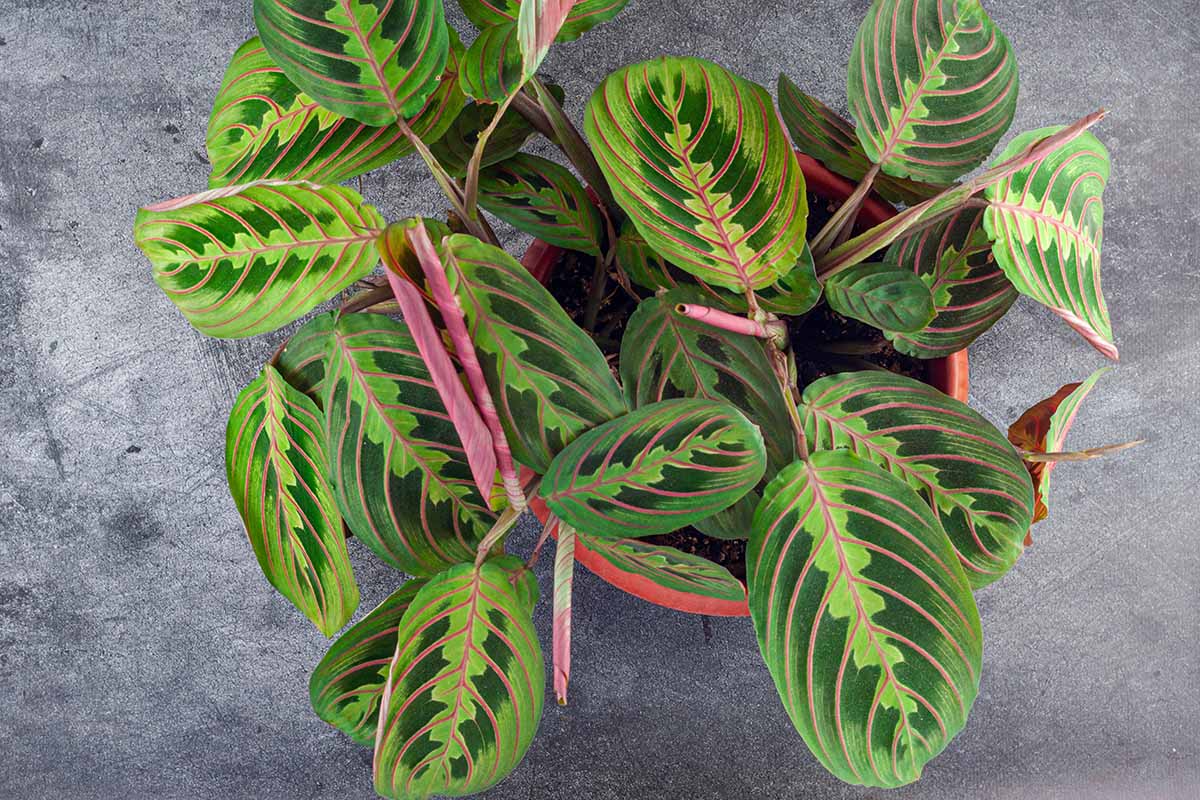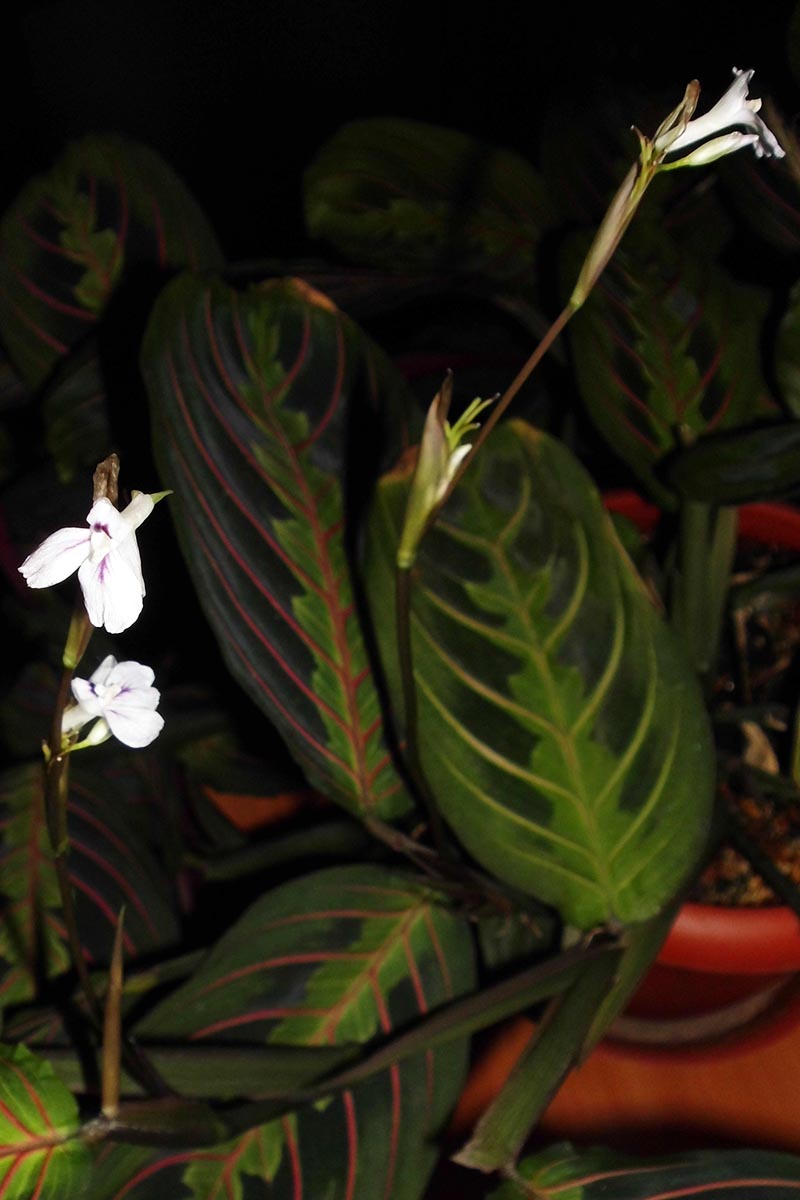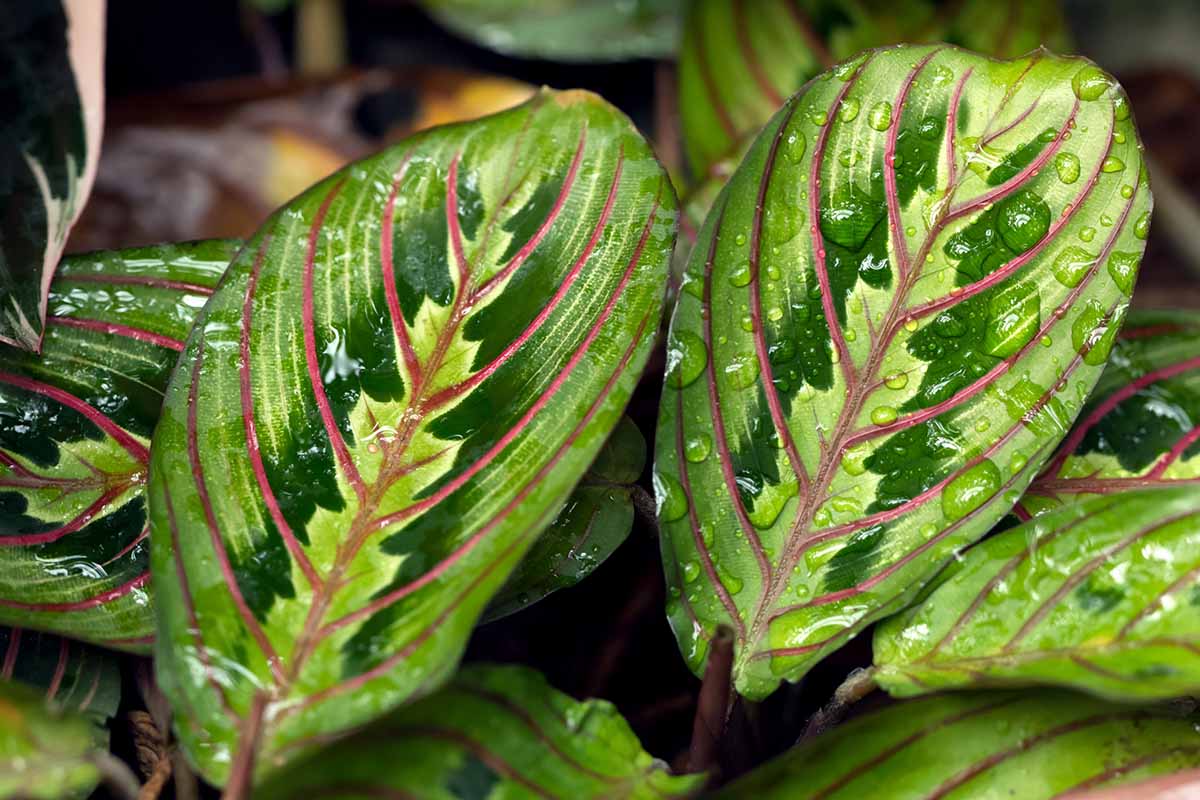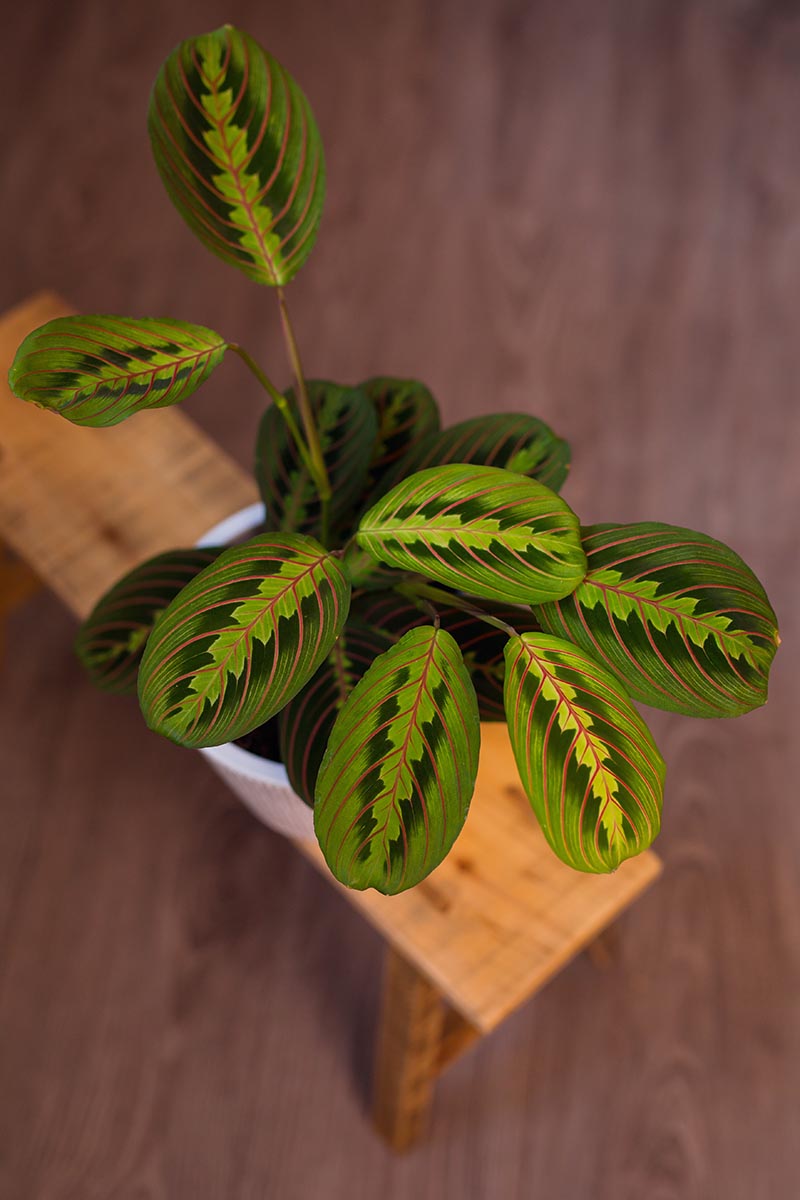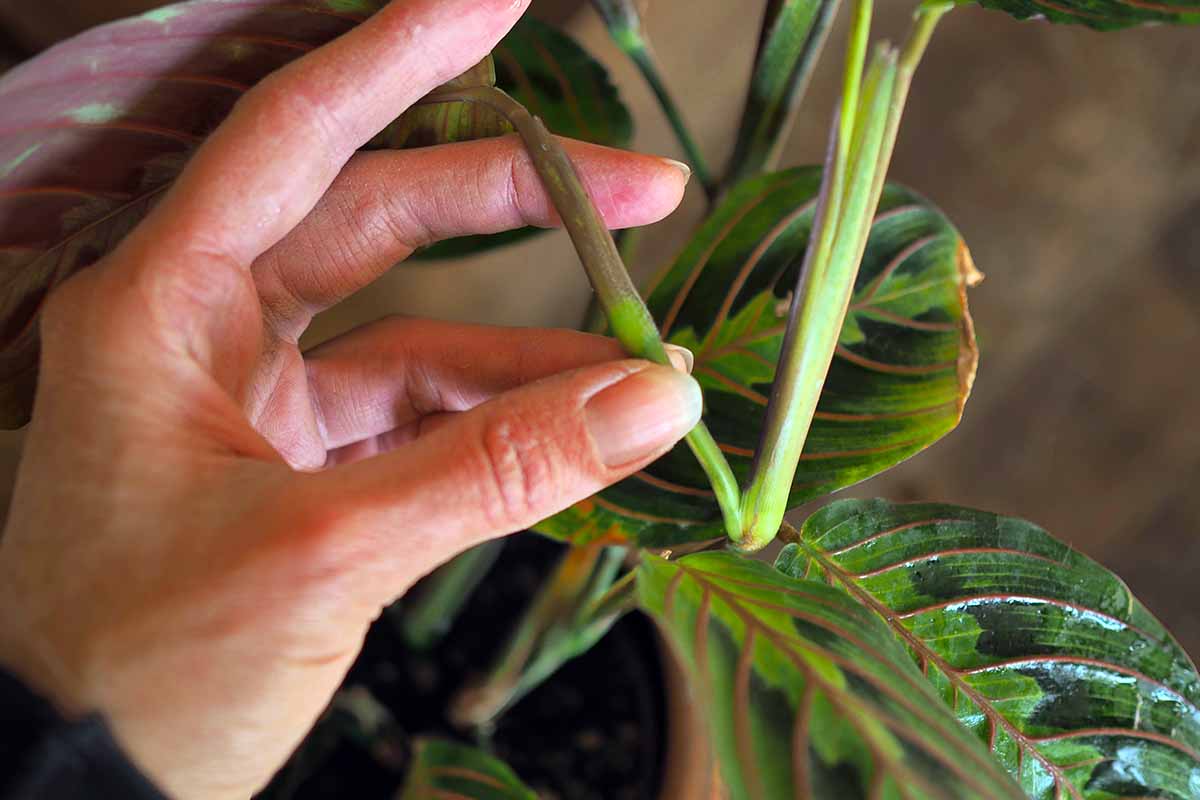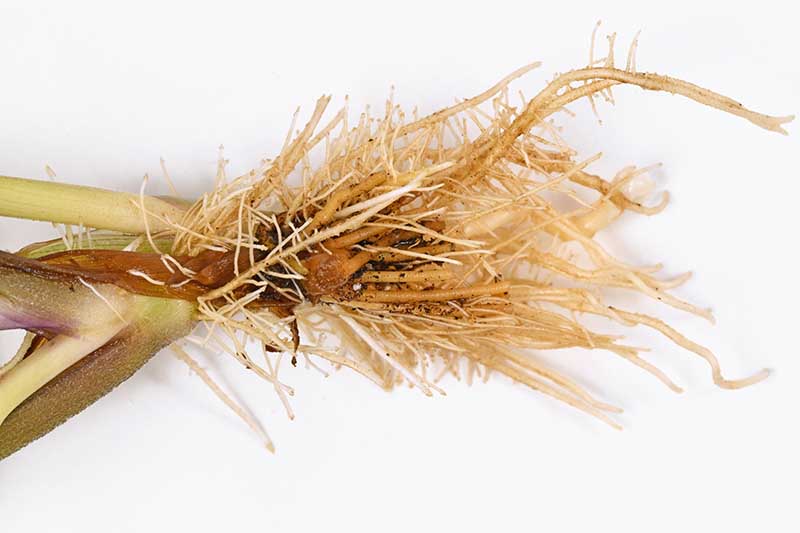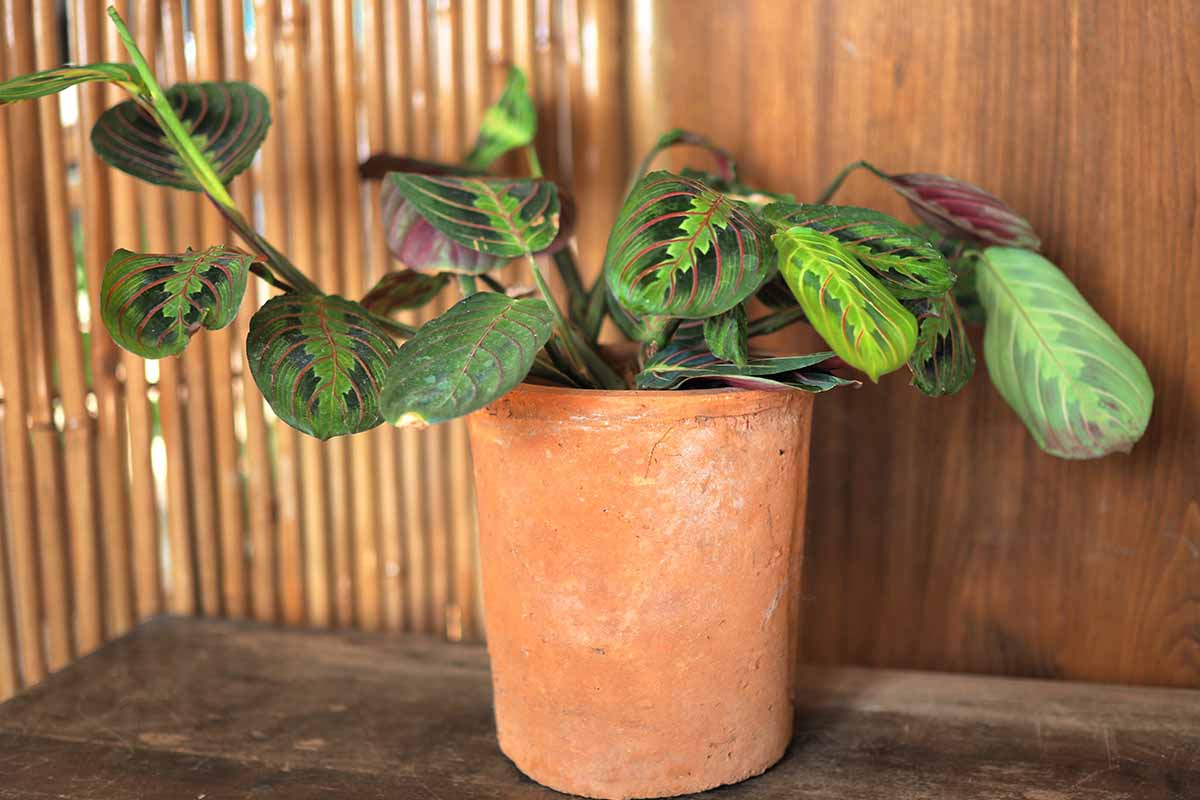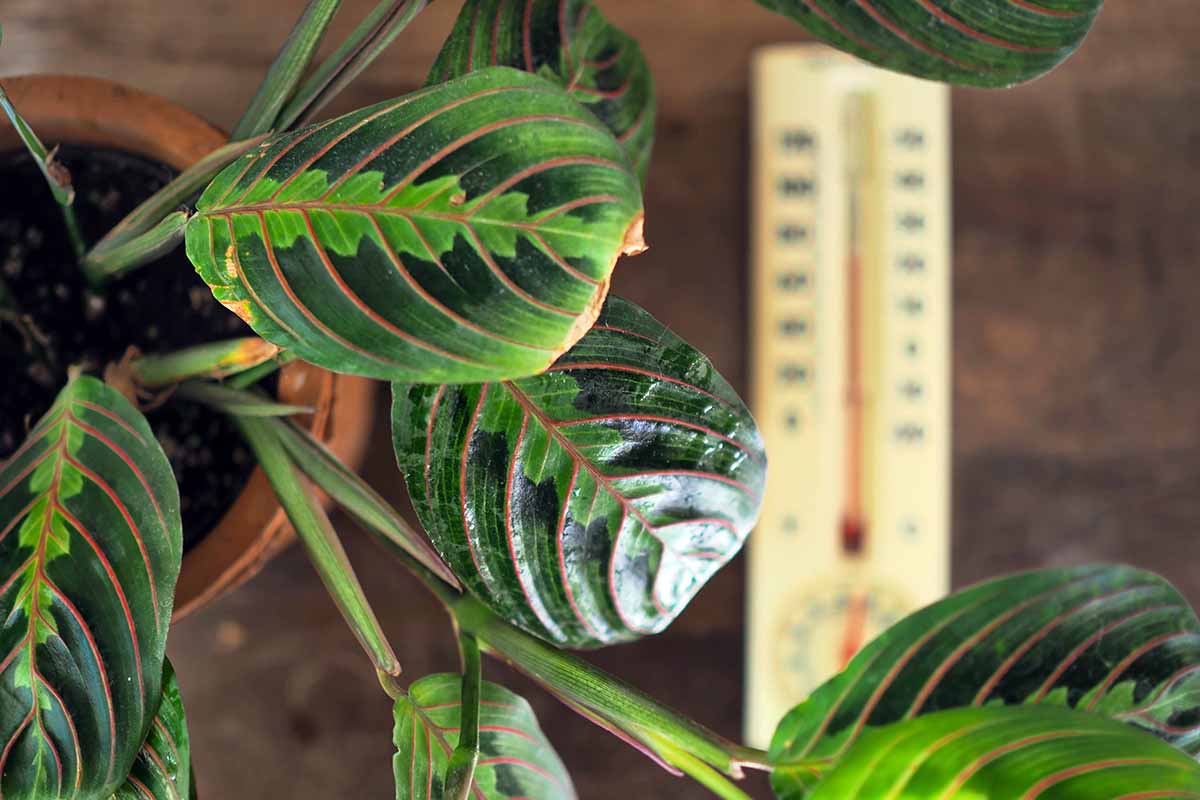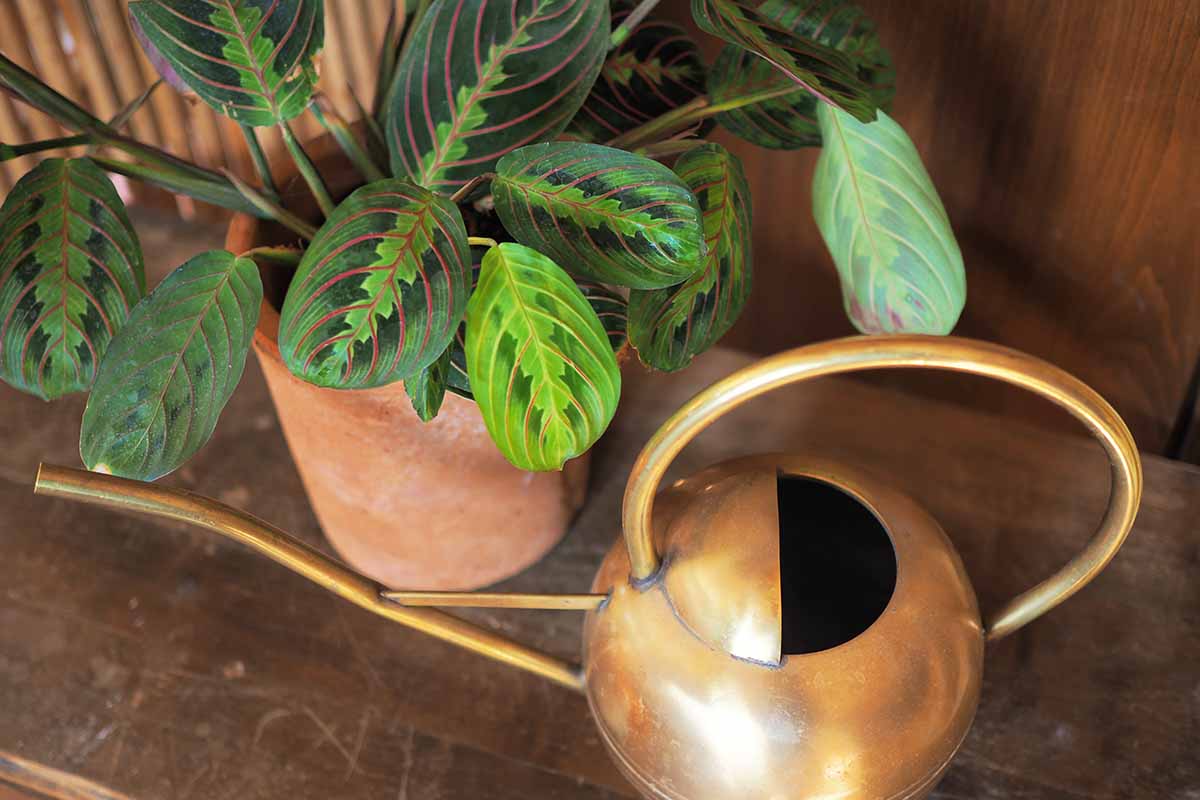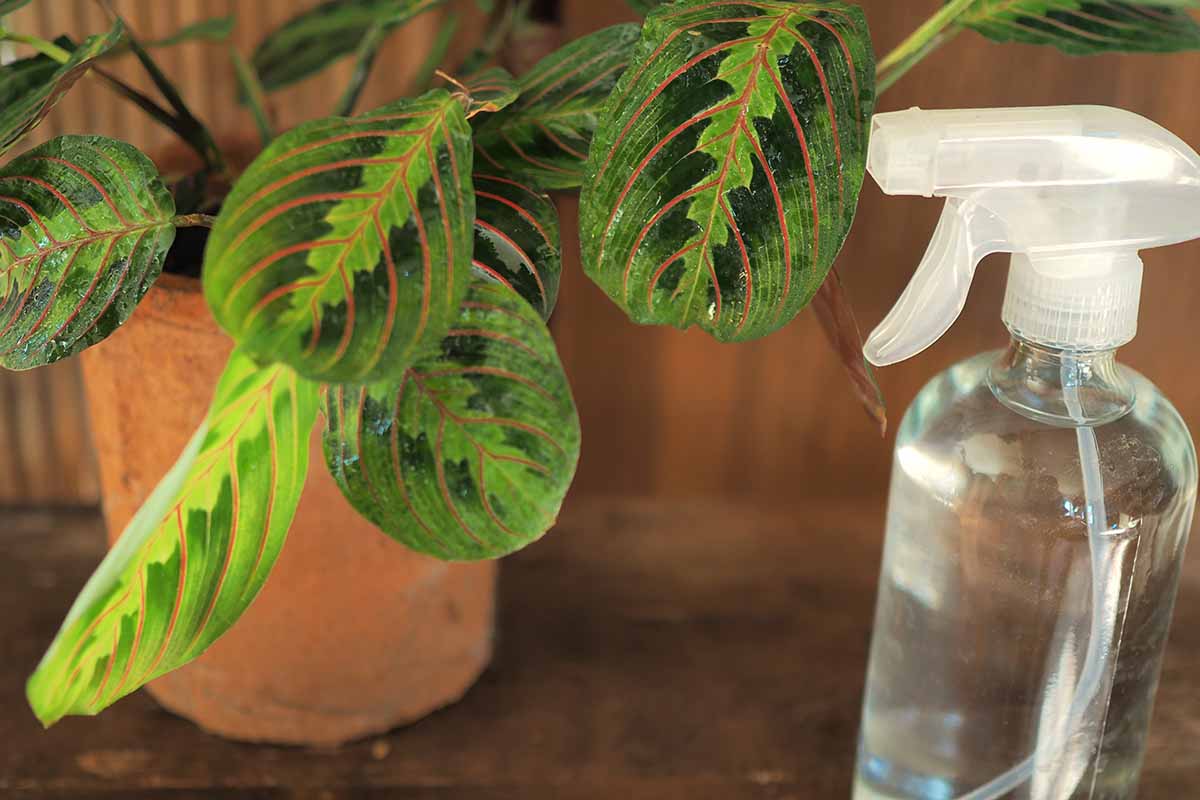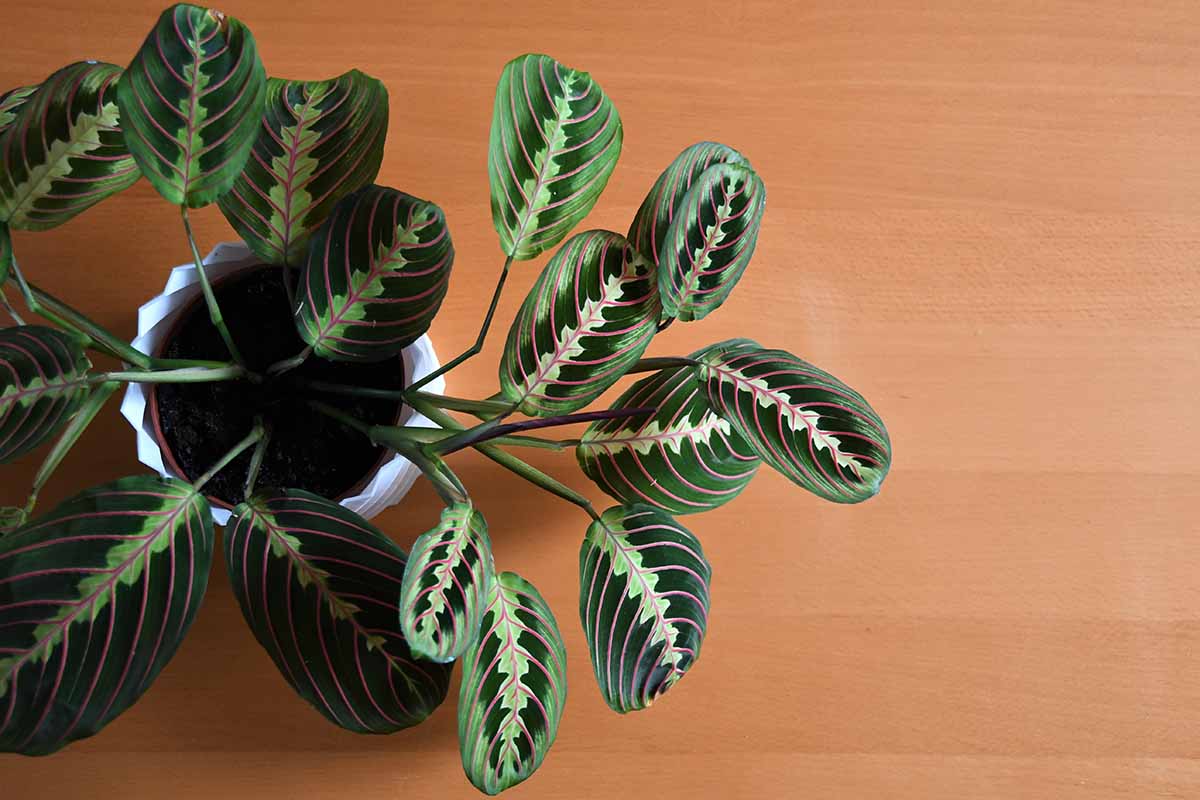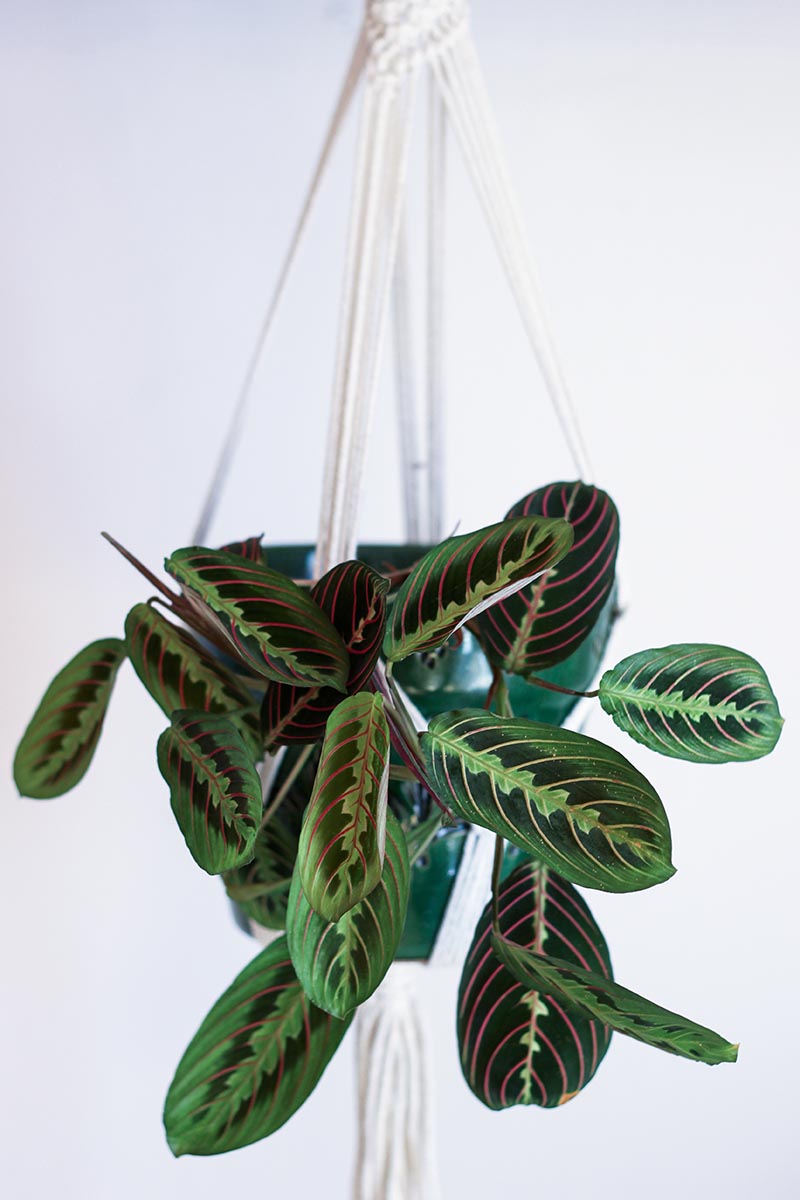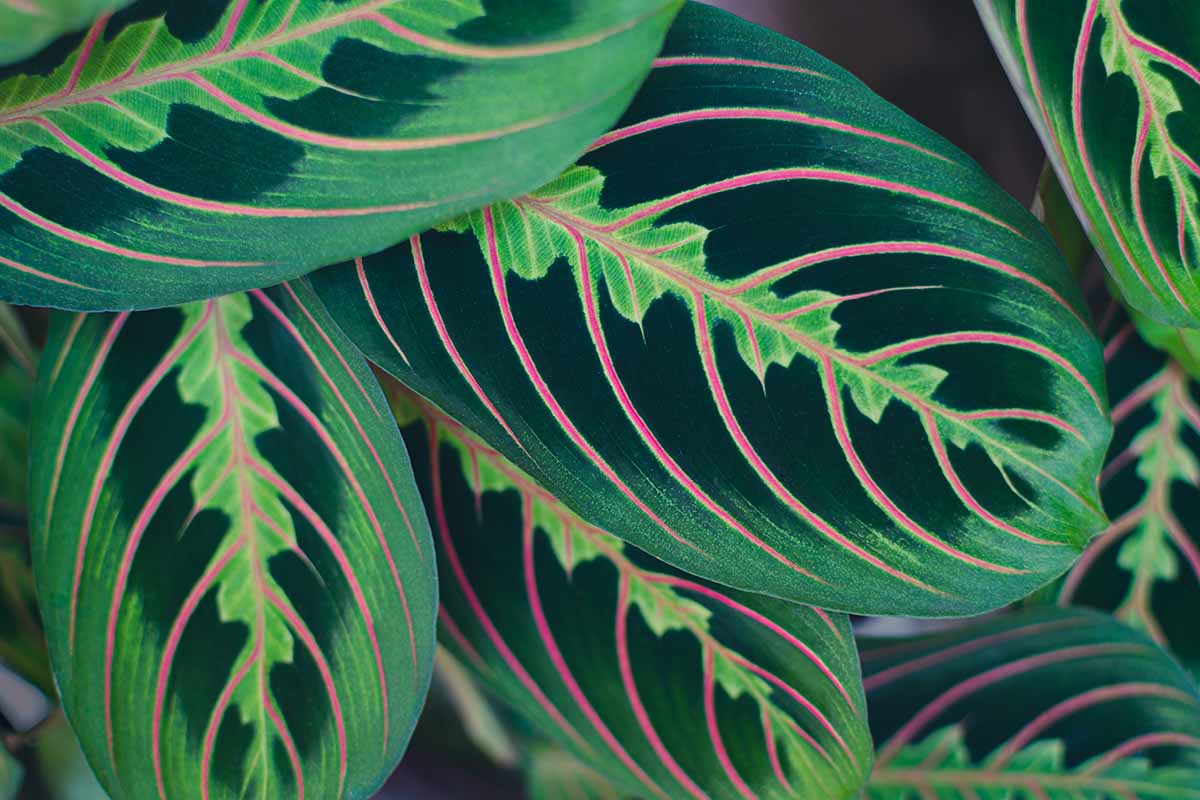On the contrary, in many ways, this tropical plant is begging to be noticed! We link to vendors to help you find relevant products. If you buy from one of our links, we may earn a commission. Well, maybe. She only needs small amounts of pampering, but she might steal the show! Ready to learn all the secrets of this sensation of a houseplant? Here’s what we’ll cover: Before we get started, let me point out that in this article we’re going to cover just one type of plant – a particular variety of the species known as Maranta leuconeura. So if you are a fan of calatheas, stromanthes, and ctenanthes as well as marantas, make sure to also read our complete guide to growing and caring for prayer plants where you’ll learn even more about this fascinating plant family!
What Is Red-Veined Prayer Plant?
M. leuconeura var. erythroneura, more commonly known as the red-veined prayer plant, is a naturally occurring variety of the species M. leuconeura. With bold patterns, this evergreen perennial features rounded, elliptical leaves. These leaves have smooth margins, are alternately arranged on their stems, and measure four to eight inches long. Foliage is light, medium, and dark green with red veins that sweep towards the end of each leaf. A pale green blaze travels up the center of each leaf, and on lighter colored leaves this blaze has a halo of dark green around it. The surfaces of the leaves have a velvety look and feel with raised veins that create textural interest. If all that weren’t already enough of a spectacle, new leaves emerge rolled up, displaying their undersides before they unfurl, which are light green to reddish-purple. Red-veined prayer plant foliage is produced on trailing stems which grow from rhizomes, giving the plant a spreading and clumping growth habit. New rhizomes will grow under the soil surface, but the plant can also spread by rooting at its nodes. Reaching up to two feet tall and four feet wide, M. leuconeura var. erythroneura produces small white to purple flowers, even when grown indoors. Along with the charming patterns and attractive coloration of the plant, this maranta also exhibits some fascinating behavior called nyctinastic movement, which is a sort of circadian rhythm. At night, she raises her leaves so they are closer to a vertical position than a horizontal one. That means it is bedtime! Completing the cycle, in the morning the plant lowers its leaves again, returning them to the horizontal plane. Time to wake up! If you’d like to know more about this process, and a few theories as to why these plants evolved this type of behavior, be sure to read our guide to prayer plant care that I mentioned earlier in the article.
Cultivation and History
M. leuconeura var. erythroneura is native to Brazil, growing in tropical forests where it lives in humid conditions and grows in moist soil, but is protected from hard rains by the tree canopy. A member of the Marantaceae or prayer plant family – also called the arrowroot family – the red-veined prayer plant is related to other stars of the houseplant world such as pinstripe plant, peacock plant, and rattlesnake plant. You may be familiar with an ingredient produced from a member of the Marantaceae family if you have ever dabbled in gluten-free baking – the roots of Donax canniformis are used to produce arrowroot starch. Sometimes classified for botanical purposes as M. leuconeura ‘Tricolor,’ this variety of M. leuconeura is also known as “herringbone plant” or “red-veined maranta.” This variety is sometimes referred to as “red nerve plant” too, but that common name is more often used for a smaller but very colorful houseplant also known as fittonia. And as is fitting for a would-be diva, the subject of our article is no stranger to accolades. The Royal Horticultural Society’s Award of Garden Merit was bestowed upon M. leuconeura var. erythroneura in 2002. Outdoors, red-veined prayer plants can be grown in USDA Hardiness Zones 11 to 12, but only in non-arid climates. Remember, this verdant beauty has tropical roots!
Propagation
Red-veined prayer plants are easy to propagate from division or via cuttings in either soil or water – we’ll cover all three processes here.
From Cuttings in Water
Propagating cuttings in water is a great technique for when you are pruning your houseplant but don’t feel like pulling out your potting supplies. You can just take a healthy cutting, stick it in a glass of water, and it will eventually grow roots – if, that is, you include a node when you take your cutting. You may be able to see small root buds on the nodes of the maranta. These buds can grow into roots to anchor themselves into the soil – or water, as the case may be! Make sure to take a cutting below a node. Place cuttings in a glass of water or a jar and situate in a location with medium, indirect light. A transparent container will make it easier for you to see when the water level is getting low. Once the roots are a couple of inches long, you can transplant your cutting into a nursery pot. It’s a good idea to actually pot up these cuttings at some point rather than just leaving them in water indefinitely, because water can evaporate from glasses or jars without a usually attentive houseplant parent noticing! And without water, the cuttings won’t live very long.
From Cuttings in Soil
It’s a good idea to gather all of your supplies first, before you begin the process of rooting cuttings in soil. Here’s what you’ll need for this propagation project in addition to cuttings: potting soil, nursery pots, and a humidity dome or plastic bag. You should also have a sterilized pair of scissors or garden pruners ready to snip cuttings from the parent plant. As far as nursery pots go, here’s how to calculate what size you’ll need and how many: You can place one cutting in a two-inch pot, two cuttings in a three-inch pot, or three cuttings in a four-inch pot. If the pots you have available don’t match these specifications precisely, that’s okay – these measurements are meant to give you a rough idea of what’s recommended, and it doesn’t have to be exact. When taking cuttings of red-veined prayer plants, harvest stems that have one to two nodes each and at least one leaf. Fill pots with growing medium, leaving half an inch to an inch of room between the surface of the soil and the rim of the pot. I’ll provide recommendations on what type of growing medium to use a bit later in the article, so keep reading! Water the soil so it is moist but not drenched. Now poke a hole or holes into the soil so you can easily insert the cuttings. If you are potting more than one, position them so the leaves are facing out. Firm up the soil around the cuttings, then cover the pot with a humidity dome or plastic bag. Place the rooting cuttings in a location with medium, indirect light. Keep the growing medium moist and the humidity dome or covering on until the cuttings take root, which may take a few weeks, then gradually transition them out of their humidity dome to adjust to normal indoor conditions.
By Division
In addition to propagating red-veined prayer plants by rooting cuttings, this maranta can also be propagated via division. When deciding whether your maranta is ready to divide, check for separate stems emerging from the soil. If you see more than one clump of stems emerging from the growing medium, you could potentially transplant each clump into its own pot. If you decide your specimen is ready to be divided, you’ll need nursery pots and growing medium. As with cuttings, you can place a single clump in a two-inch pot, two clumps in a three-inch pot, or three clumps in a four-inch pot. When you are ready to start, prepare the pots by filling them with a layer of growing medium about an inch or two thick. Use your fingers to gently work a clump away from the main stem of the plant – the division should easily pull away. Once you have a separate clump, position it in the nursery pot so the crown is about an inch below the rim of the pot. Fill in with growing medium, being careful not to cover the crown. If potting more than one clump per container, space them out evenly, leaving at least an inch or so between each clump and situating them so the foliage is facing outwards. Water your newly potted specimen until water runs out of the drainage holes in the bottom of the pot. These divisions won’t need to be repotted for another couple of years. Care for them as you would the parent plant – tips for this are coming right up.
How to Grow
While the red-veined prayer plant doesn’t present as much of a learning curve for beginning houseplant gardeners as, say, a pitcher plant, it will be well worth your time to find out what this plant needs in terms of light, water, humidity, and soil. Equipped with this knowledge, you will be able to provide it with everything it needs as a thriving, verdant member of your household.
Choosing a Plant
It’s important to learn what types of pests and diseases to look for in these marantas so you can avoid problematic-looking specimens when you choose one to purchase. Avoid specimens displaying any discoloration or crispy leaves – unless you are feeling motivated to ensure a round of houseplant rehabilitation! You’ll learn more about spotting signs of pests and diseases a little later in this guide.
Light
Situating your maranta in a location where it will receive the right amount of light is your first important task in making sure this houseplant is ready to prosper. Red-veined prayer plants will thrive in medium to bright, indirect light. These marantas can also tolerate low light, though their markings will become less pronounced in reduced light conditions. On the other hand, if you notice that the patterns on your specimen’s leaves are starting to look bleached out, it’s likely getting too much light. A little direct sunlight in the morning is fine, but avoid too much direct sun exposure, which can scorch the leaves.
Temperature
Red-veined prayer plants will thrive in temperatures between 70 and 90°F. However, as temperatures rise, take care to check these houseplants more frequently to see if they need water, especially during heatwaves. If your home isn’t climate controlled, you may need to move your houseplant as the seasons change to keep it comfortable. I move my marantas, calatheas, and stromanthes to the cooler, northern side of my un-air-conditioned home during the hottest part of the summer. As for cold temperatures, this maranta will suffer damage if exposed to temperatures below 55°F. In addition to keeping this houseplant in fairly comfortable climatic conditions, avoid placing it in areas exposed to hot or cold drafts, such as near fireplaces, exterior doors, or drafty windows.
Water
When it comes to your watering routine, think back to where this maranta originates – on the tropical forest floor where its “feet” remain moist but not drenched. Translating that into houseplant terms, keep its soil moist, but not soggy, and provide it with water when the surface of the soil is dry. Determining how often you’ll need to water will depend on many factors – whether your specimen is situated in bright, medium, or low light, the temperature in your home, how potbound the specimen is, and what type of growing medium is filling its container. You may need to water only once a week during spring and fall, for example, a bit more often during summer, and perhaps only once every 10 days or every two weeks during the winter, depending on your conditions at home. But knowing how often to water isn’t the end of your maranta irrigation education – there’s more! These plants are very sensitive to impurities in water and will start to produce brown or yellow leaves if you cut corners here. To keep your herringbone plant looking and feeling its best, use filtered water, distilled water, or rainwater. And for best results, use a houseplant-adapted watering can to pour water evenly over the soil surface until liquid runs out of the drainage holes in the bottom of the pot. Um – your pot does have drainage holes, doesn’t it? (Keep reading – you’ll learn why this is a must later in the article!) If your pot is sitting in a saucer, either empty the saucer immediately after watering, or – better yet – remove the container from the saucer and place it in a bowl, sink, or tub while watering. Give it a few minutes to drain before you put it back in its usual spot. You might also consider bottom watering this maranta. And one more tip while we’re on the subject: if you have a hard time keeping track of your watering schedule and can’t remember if you watered three or 13 days ago, consider noting your houseplant irrigation efforts in a gardening journal or online planner. Regardless of the number of days that have passed since your last watering, always be sure to check the soil with your finger or a soil moisture meter, and lift pots to check their weight – moistened soil is heavier!
Humidity
Red-veined marantas appreciate a bit more humidity than some houseplants, in the range of 50 to 60 percent. A lack of humidity is one of the most common problems that leads to brown leaves in prayer plants – though there are other causes too, which you can learn about in our article. Sure, go ahead and mist your maranta! If nothing else, it will help to clean some dust off the plant’s leaves. You can easily assess ambient humidity with a handy gauge called a hygrometer. Making houseplant care even easier, thermometers and hygrometers are often paired in one neat package. Mini Indoor Thermometer and Humidity Gauge I like this combo thermometer and humidity gauge – it’s small enough to nestle on a tabletop among a group of houseplants, but it can also be hung on a wall nearby. And it’s analog, so it’ll never need electricity or batteries. Keep seasonal variations in mind. Conditions in winter versus summer are often quite different, due to the drying effect of indoor heating systems. Once you measure your indoor humidity, you can choose one or more of several different methods to increase humidity for your maranta, depending on your needs. “Oh, increase humidity? You must mean misting,” I can sense you thinking, through the ether… Just be sure to use the same high-quality water you would use to irrigate your specimen. Otherwise, spritzing it might leave water marks behind. But even if it doesn’t create unsightly marks, spritzing plants often fails to be enough to keep humidity levels sufficiently high. There are other methods you may wish to use as well. One of my favorites is the buddy system. Group your maranta with some buddies and you will create a more humid microclimate within your home. And hey, choosing this option is a great excuse to acquire additional houseplants! In my arid climate, prayer plants need even more of a boost. If the buddy system is not enough to raise the humidity to the needed level, you might also want to allow water to evaporate around your plant on a regular basis.
Soil
Red-veined prayer plants grow best in a peaty growing medium with a pH of 6.1 to 7.3. The tray is filled with water and the plant is situated either on pebbles placed in the tray or on a sturdy grid, so the base of the pot doesn’t come into direct contact with the water. 10.5 x 13.5” Black Plastic Humidity Tray Because my indoor air is on the dry side, I use all of the tactics I already mentioned for my marantas, plus one more thing – I group them in terrariums and mini greenhouses, which come with the added bonus of keeping my cats from harassing my houseplants! There are many different types of mini greenhouses and terrariums available for housing houseplants, so choose one to fit your decor and your purposes. 9.8” x 7.9” x 5.9” House-Shaped Glass Terrarium And there’s one more method you may want to try, especially if you have a larger specimen that won’t fit nicely into a terrarium – a humidifier. Using a humidifier especially adapted for houseplants is a great way to humidify a large space, and this is helpful if you are cultivating not just a houseplant or two, but more of an indoor jungle. However, just because they grow well in peaty soil, doesn’t mean they require actual peat moss, a horticultural ingredient that comes with a dark side. Marantas will perform beautifully in alternative growing mediums as well, including those consisting of coconut coir and compost. To keep your maranta looking tip-top, you’ll also want to avoid soil mixes that contain perlite, as this ingredient contains fluoride which may lead to leaf tip burn.
Growing Tips
Provide medium to bright, indirect light.Keep soil moist but not soggy, and provide water when the soil surface is dry to the touch.Avoid drafts and temperature extremes.
Pruning and Maintenance
Red-veined prayer plant isn’t an especially high maintenance houseplant, providing lots of bang for your buck without too much of a time investment. One of the growing mixes I have found that meets all these requirements, and that my marantas love, is De La Tanks Soil Mix. It contains both coconut coir and compost, as well as worm castings, pumice, and organic fertilizer. De La Tanks Soil Mix Another option is mixing up your own from individual ingredients! Learn more about what goes into creating the perfect houseplant potting medium in our guide. Here’s all you need to know when it comes to maintenance:
Pruning
There are a few reasons why you may want to prune your maranta – to shape the specimen, to take cuttings for propagation, or to trim away any discolored foliage or dead flowers. You may see the occasional yellow leaf, which can be removed with a pair of snips or scissors – just make sure you sterilize your tools first. To keep marantas looking their best, when pruning entire leaves, remove the leaf’s stem as well. Also, your specimen may produce small flowers from time to time. After these fade, trim them back to the stem to keep the plant looking tidy. If you spot any browning leaf tips, these can also be trimmed.
Fertilizing
When it comes to prayer plants like marantas, fertilizing is a good idea but only when it’s done very gently. Choose a fertilizer formulated for use on tropical houseplants and apply it at a low dose. Otherwise, you may burn the leaves of your houseplant. What type of fertilizer should you use? A gentle product recommended for tropical species is best, preferably a natural one. Worm compost tea is a good option here, and you can make a simple preparation by soaking castings harvested from your worm compost system in water. If vermicomposting isn’t among your hobbies or part of your skill set at the moment, a very easy way to use worm compost to nourish your houseplants is with worm compost tea sachets. And there are a couple of very important differences between worm compost tea sachets and the type of tea you might drink! The first (hopefully obvious!) way in which they differ is that this is not intended to be served alongside gingersnaps – that’s right folks, don’t try drinking it yourself, save it for your houseplants! On the other hand, we do have lots of information on medicinal species in other articles if you’re looking to make healthful infusions and tisanes for human consumption… But I digress! The next difference is that you don’t use hot water to make this type of tea. Instead, you simply let it infuse in room temperature water.
Repotting
These marantas are faster growers than most other types of prayer plants, but nevertheless, you will probably only need to repot once every two years on average. Earthworm Technologies makes convenient ready-to-use sachets called Teadrops which are filled with earthworm compost. Teadrops Worm Compost Fertilizer Fertilizer should be applied once a month during the growing season. Rather than sticking to a predetermined schedule, look for signs that your plant is becoming root bound before repotting. If it’s drying out too quickly between waterings, or roots are emerging from the top of the soil or the drainage holes, it may be time to repot! On the other hand, it’s best to avoid repotting specimens that are still comfortable in their current containers. If you place a red-veined prayer plant in an oversized pot, you won’t be doing it – or yourself – any favors. When it’s time, choose a pot that is just one size larger than the current container and make sure it is equipped with holes in the bottom to provide drainage. In addition to a new pot, you’ll also need some fresh growing medium. Be sure to review the section on soil above to find tips for selecting one that is appropriate for marantas. Now that you have your soil and a new pot, pour a layer of soil about an inch or two thick in the bottom of the container. Remove the specimen from its old pot, then rough up the root ball a bit with the palm of your hand. Some of the old growing medium will likely fall out when you do this – rather than discarding it, mix it into the new growing medium. This will help the maranta’s roots move more easily between the old and new soil. But please note, if the old soil is poorly suited to red-veined prayer plants or if the specimen is suffering from root rot, you should not mix any of the old soil into the new. Situate the maranta in its new pot and check its level – the top of the root ball should be about an inch below the rim of the pot. If needed, adjust the amount of soil under the root ball to either raise or lower the specimen in the pot. Once the root ball is situated at the right level, start to fill in with potting soil, using the mix of old and new. Water it in and return it to its usual well-chosen location. Since it’s always easier to prevent a pest or disease problem than to deal with an ongoing one, your first step in prevention is to know what to look for before you purchase a new specimen, as mentioned above. You will commonly find M. leuconeura var. erythroneura available for purchase in two-inch pots on the smaller end, or in six-inch hanging baskets on the large end of the spectrum. Live Red-Veined Prayer Plant in 3-Inch Nursery Pot
Managing Pests and Disease
Many maranta fans grow these herringbone plants without encountering any disease or pest problems. Once the newbie is settled into your home, give it a good inspection each time you water. And if you like to place your houseplants outdoors for the summer, be sure to check again before you bring it back indoors.
Insects and Arachnids
It’s a good idea to check these houseplants regularly for signs of pests. Here are a few of the most common ones you may encounter:
Mealybugs
While you may associate the word “mealy” with poor texture in apples and tomatoes, couple it with the word “bug” and you get a whole different type of negative association – one that means your houseplant is in danger. Mealybugs, so named because they and their eggs resemble a floury-looking residue on foliage, are nutrient-sucking pests that can weaken and eventually kill a plant. In addition to this nutritional theft, mealybugs also leave sticky trails of honeydew behind, which can provide fungal organisms an opportunity to grow. Does this sound like something you are seeing on your maranta? If so, quickly isolate it from your other houseplants to avoid letting the mealybugs spread. Next, apply neem oil spray to the tops and bottoms of the leaves, the stems, and the base of the plant. While neem oil will kill mealybugs, it is nontoxic to humans and pets, so at least there’s one thing you won’t have to worry about!
Scale
If you are new to the world of houseplants, or at least to the world of houseplant pests, scale insects are right up there at the top of the “pests to know” list. Just keep applying more once a week, ensuring good coverage all over the plant, until you get rid of those little white monsters. Theraneem Neem Oil, 16-Ounce Bottle This product will need to be diluted prior to applying it, so be sure to read the manufacturer’s instructions before you douse your houseplant. Ready-to-spray products are available as well. Want to learn more about mealybugs? Check out our article. These nutrient-sucking insects can weaken and eventually kill a plant. Sound familiar? Scale insects are related to mealybugs, the other pests you just encountered. Like mealybugs, they will also leave shiny trails of honeydew on stems and foliage. However, their similarity to mealybugs ends when it comes to their outward appearance. While mealybugs are highly visible, though camouflaged, scale insects have evolved to be unnoticeable. They have hard or soft outer shells that seem to meld with the plant tissue, leaving you wondering, “is that spot just a little nick on my houseplant’s stem?” If you run a finger over the spot, you will feel a raised bump. Try to scratch it off. If liquid comes out of the bump, it’s likely scale. If you determine that you do indeed have scale insects living and dining on your maranta, neem oil is a remedy that will work against these pests as well. Need more help battling these pests? Be sure to read our article on identifying and controlling scale.
Spider Mites
Departing just a bit from insect problems, there is also an arachnid you should be aware of as a houseplant pest – the dreaded spider mite. Spider mites also like to suck juices from plant tissue – are you noticing a trend here?! These pests can cause stippling on foliage, which looks like tiny yellow dots. They also leave webbing on foliage and stems. The mites themselves are usually hiding on the undersides of leaves, so give your houseplant a good inspection with each watering. Once again, neem oil will be your friend if you have suddenly discovered a colony of spider mites on your maranta. Read our article to learn more about detecting and controlling spider mites.
Disease
Disease doesn’t show up very often in marantas, but on rare occasions some specimens might succumb to certain pathogens. Here’s what to look for:
Cucumber Mosaic Virus
While interesting foliage patterns are one of the reasons red-veined prayer plants are so beloved, the pattern caused by cucumber mosaic virus is nothing to celebrate. This pathogen, which is spread from specimen to specimen, can create a yellow mosaic pattern on infected foliage, and can also cause them to have deformed leaves, yellowing veins, or spots on their foliage. Related to turnip mosaic virus, there is no known cure for this pathogen, so be sure to wash your hands and sterilize any garden tools in between handling different specimens to prevent further spread. Damage in some houseplants is only cosmetic, but sadly, the only way to prevent the spread of this virus is by disposing of infected specimens.
Helminthosporium Leaf Spot
What if you notice strange markings on your maranta’s foliage that are not mosaic-like in appearance but look more like spots? If you see brown or tan lesions outlined in yellow, your maranta is likely infected with Helminthosporium leaf spot. This is a disease caused by Bipolaris and Drechslera species of fungi, which flourish when temperatures are mild and conditions are damp. Infections can be prevented with proper watering habits – water the surface of the soil rather than sprinkling the foliage. And when you do want to give your plant a shower, do so on sunny days and preferably in the morning, so the plant has time to dry before temperatures drop at night. If prevention is no longer an option and your prayer plant has a full-blown infection, reach for that bottle of neem oil, the same nontoxic product used to control pests on marantas. Neem oil is a fungicide as well as a pesticide.
Root Rot
Unfortunately, there is a very real risk of running into problems with root rot, an issue that tends to be brought on by either an inattentive or overly attentive plant parent. Fortunately, this condition is easy to avoid. But before we get to prevention, first let’s learn when this disease is likely to be a problem. Are the leaves of your maranta starting to turn yellow and wilting despite the soil being wet? Is the soil very wet? Do you frequently forget to empty your houseplant’s saucer after you water? Do you find yourself dumping any unfinished glasses of water into your plant’s pot, whether you have recently given it water or not? Is your maranta planted directly into a pot that doesn’t have drainage holes? If you answered “yes” to any of those questions, (cue ominous music…) you may just have a problem with root rot – and if you don’t yet, you may in the future. If it’s looking yellow-leaved and wilty already, your plant may or may not be salvageable at this point. Chances are slim, but if you want to give it a try, here’s what you can do: Check the stem where it is emerging from the soil – are you seeing any mushiness or signs of fungus such as white discoloration? If not, remove the plant from its pot to inspect the roots. Plants suffering from root rot will have mushy roots rather than healthy, firm ones. To try to save your plant, you can trim off any mushy roots and repot the specimen into fresh growing medium, either in a new pot or one that you’ve sterilized. If you think root rot is indeed happening, another way to save the plant is to take cuttings from any stems that still look healthy and propagate those, giving the houseplant a new life in case the parent maranta doesn’t make it. If root rot doesn’t seem like it’s to blame, you can learn more about troubleshooting yellow leaves on prayer plants in our article. To prevent this problem in the future, make sure whatever pot you use has drainage holes and that you never let it sit in a saucer of water. You’ll also want to make sure the growing medium drains well, the nursery pot is the right size, and that you aren’t watering too often.
Best Uses
Now that we have all the worst-case scenarios out of the way, let’s explore some of the many ways you might use this lovely plant! Whether it’s nestled into a decorative pot on a tabletop or suspended from the ceiling in a gorgeous hanging basket, this eye-catching selection will add an element of je ne sais quoi to nearly any decor. Herringbone plants can also be used in a vertical indoor garden, or as ground cover in an interiorscape. You might also consider this maranta to include in a large terrarium. And since red-veined prayer plant is nontoxic, you can bring it into a home with small children or pets without any worries. For those who live in non-arid locations within USDA Hardiness Zones 11 to 12, red-veined prayer plant can be used outdoors as a shade or part-shade ground cover. She will thank you for it with mounds of gorgeous foliage. Do you have a herringbone plant that is lighting up your life? Need any help troubleshooting a plant health problem? Let us know in the comments section below and be sure to post a photo or two! All right, houseplant pals, we have come to the end of this article. But I have some good news – we have more prayer plant articles for you, so keep exploring the lush and lovely foliage of our Marantaceae friends right here:
21 of the Most Stunning Species of Prayer Plants to Grow at HomeHow to Grow Stromanthe Triostar HouseplantsWorth Its Stripes: How to Grow and Care for Calathea Zebrina Plants
